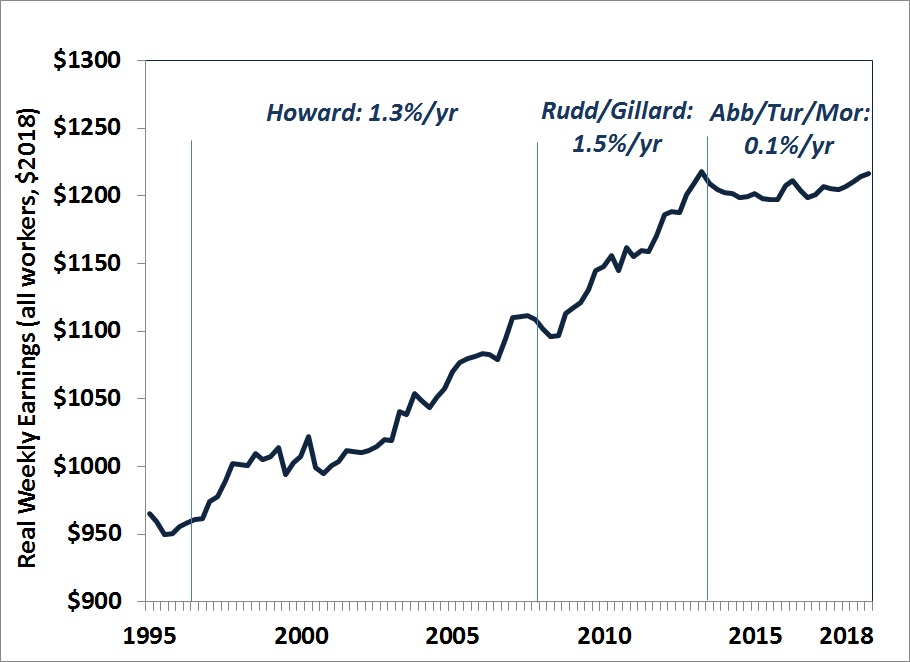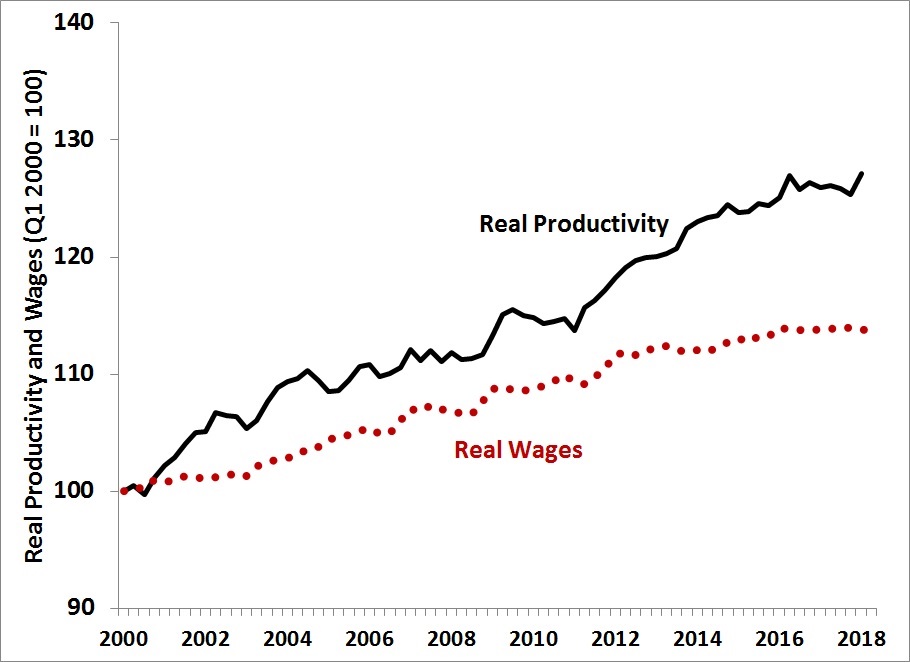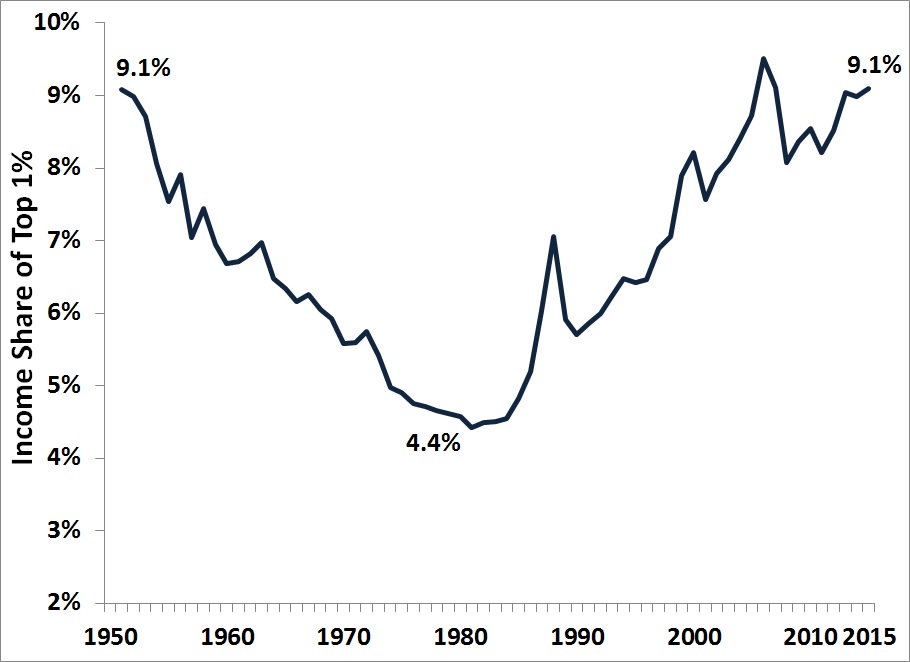Denying Wages Crisis Won’t Make It Go Away
Share
As the great novelist Isaac Asimov wrote, “The easiest way to solve a problem is to deny it exists.” Business leaders and sympathetic commentators have adopted that advice with gusto, during current public debates over the unprecedented weakness of Australian wages.
Even as Australian voters express great concern over stagnant wages, and strong support for policy measures to boost wages (like restoring penalty rates and lifting minimum wages), business leaders continue to claim that wages are doing just fine, thank you.
In this commentary, Centre for Future Work director Jim Stanford challenges this attitude of denial. The empirical evidence is overwhelming, he argues, that traditional wage mechanisms have broken down in Australia – and as a result workers are not getting a healthy share of the productivity they produce.
Denying Wages Crisis Won’t Make it Go Away
by Jim Stanford
As the great novelist Isaac Asimov wrote, “The easiest way to solve a problem is to deny it exists.” Business-oriented commentators have adopted that advice with gusto, during current public debates over the unprecedented weakness of Australian wages.
Since 2013 average wages have been growing at about 2% per year. That’s the slowest sustained growth since the end of the Second World War. Wages have barely kept up with consumer prices in this time, which means that workers haven’t had a real wage increase (measured by the purchasing power of their incomes) in six years.
Meanwhile, in contrast to the freeze in real wages, labour productivity has continued to move ahead: by around 1% per year. The traditional assumption that real wages will automatically reflect higher labour productivity was never justified. Productivity growth creates economic space for higher wages (without impinging on profit margins), but there’s never a guarantee that productivity growth will automatically trickle down to the workers who produce it. Workers need the power to demand and win those increases. Nowadays, however, there’s no visible link between wages and productivity at all.
The grim trend in wages has sparked grassroots anger in working class families and communities across Australia. Workers have seen prices for many essentials growing, and their wages barely — if at all — keeping up. The promise of a “fair go,” and the dream of middle-class prosperity, seems further and further away. Labor leader Bill Shorten declared that the current election would be “a referendum on wages.” Given the bubbling frustration among Aussie battlers, that prediction is credible: and if it comes true, would pose a direct challenge to both the credibility of the business community, and the electoral fortunes of the current government.
So defenders of the status quo are now invoking a healthy dose of denial. (And, no, we don’t mean the river in Africa!). They deny there is anything untoward about recent wage trends. They deny that inequality is getting worse. And they deny the role of institutional changes (like weaker labour laws and declining unions) in explaining those trends.
In other words, there’s nothing to worry about. Nothing to see here, folks. And certainly nothing to justify changing the direction of labour policy in Australia — which for over 30 years has focused on suppressing wages, not stimulating them.
A good example of this denial in action was provided this week by a long commentary from Michael Stutchbury, editor-in-chief of the Australian Financial Review. The article argues that the focus of union campaigners and social advocates on wage stagnation and growing inequality is unjustified, and that Australian workers have in fact been treated fairly. His specific claims include:
- Real wages are higher than they were 15 years ago.
- Real wages have kept pace with productivity growth, and workers have received their “fair share” of productivity gains.
- Labour is receiving the same share of GDP as it did 60 years ago — and to the extent that the capital share of national income has grown, that has also benefited workers (who he terms “quasi-capitalists”).
- There has been no significant increase in inequality.
- Taking steps to restore union bargaining power and reform other labour institutions are not necessary, and wouldn’t work anyway.
Similar claims have been advanced by other business-friendly commentators and conservative politicians — all pushing back against the ambitious demands of the #ChangeTheRules movement to strengthen wage-supporting policies and institutions (like minimum wages, penalty rates, and collective bargaining). But Stutchbury’s commentary is notable both for the scope of his claims, and for his aggressive dismissal that there’s anything wrong with Australia’s labour market at all. Let’s review the facts relating to each of his major claims in turn:
#1 Real wages are higher than they were 15 years ago
Yes, real wages are higher than they were 15 years ago. But they are not higher than they were 6 years ago. As explored thoroughly in the recent collection of research published by the University of Adelaide Press (The Wages Crisis in Australia), Australia’s wage trajectory changed dramatically beginning around 2013. That’s when nominal wage growth decelerated suddenly: from traditional annual increases of 3.5 to 5% per year, to an average of 2% since then. Consequently, real wages have been stagnant. Ignoring this sudden and notable change by stretching the frame of comparison further back in history does not erase the painful memory of the last several years. As the song goes, “What have you done for me lately?”
Selective time frames cannot defuse the stark statistical reality: since the Liberal-National Coalition took office in 2013, real living standards for Australians have stagnated or (for many) declined. That’s not solely due to the government’s own wage-suppressing policies: which have included measures like capping public sector wage growth, attacking unions, and underfunding public services. But they certainly made matters worse.
Figure 1: Real Weekly Wages, 1995–2018

Source: Author’s calculations from ABS Catalogues 6302.0 and 6401.0.
#2 Real wages have kept pace with productivity growth
This claim is clearly false over any meaningful time horizon. Labour productivity has been chugging along since the turn of the century, at an average rate of about 1.25%. Some years it grows faster, some years slower. Productivity growth measures tend to be especially volatile, since they are computed as the implicit ratio of other, separately collected statistics (namely, total output and total hours worked). Some years reported productivity doesn’t seem to grow at all; some years it seems to grow very quickly.
Even before the cessation of real wage growth around 2013, real wages were consistently lagging well behind productivity growth. Since then, of course, real wages have stopped growing at all, so the gap between wages and productivity has widened. From 2000 to the present, real wages have grown half as much as real labour productivity.
Figure 2: Labour Productivity and Real Wages, 2000–2018

<>Source: Author’s calculations from ABS Catalogues 5206.0, 6345.0, and 6401.0.
Stutchbury, like some other analysts, makes much of the difference between two different methods of measuring real wages: nominal wages can be deflated by consumer prices (which matter most to workers, as depicted in Figure 2) or by the average prices of the output they produce (which matter most to their bosses). Those two price series can move in different directions for a while: usually because of the price volatility of the natural resource exports that make up a significant share of Australia’s GDP. Hence the real “consumer” wage can differ from the real “producer” wage.
But over the long-run the two price measures have moved in step, and hence the choice of deflator does not affect the conclusion that wages and productivity are no longer tied at the hip (in fact, they never were). Stutchbury actually concedes that if we use producer prices (rather than consumer prices), real wages have in fact lagged behind productivity (or, as he optimistically puts it, they “haven’t quite kept pace”). But then he makes a silk purse out of this sow’s ear by arguing that the relative cheapening of labour will stimulate more job-creation (another hollow business promise). In this mindset, it doesn’t really matter whether wages are keeping up with productivity, or not: everything is awesome in any event.
#3 Labour’s share of GDP is the same as it was 60 years ago
Unlike Stutchbury’s other claims, this one is actually true — but his interpretation of the statistic is hilariously one-sided. The labour share of GDP is defined as the total value of labour compensation (including wages, salaries, and other compensation including superannuation contributions) relative to the total output of the economy. It’s a rough-and-ready, but convenient, summary measure of workers’ overall share of the economic pie they help bake. Its evolution depends directly on the relationship between real wages and labour productivity discussed above. If productivity grows faster than real wages (as has been the case), then the labour share of GDP must decline — it’s arithmetically inevitable.
Workers’ share of Australian GDP grew steadily through the vibrant economic expansion of the initial postwar decades, for several reasons. Waged employment became the dominant way for Australians to support themselves (replacing farming and small business activity). Real wages grew rapidly, driven by industrialisation, strong unions, and Australia’s then-ambitious set of egalitarian distributional policies. The labour share peaked in the mid-1970s, and then entered a long, irregular decline. (For more details and analysis of that decline, please see our special research symposium.)
Figure 3: Labour Compensation as Share of Australian GDP, 1960–2018

Source: Author’s calculations from ABS Catalogue 5206.0.
<>By 2018, labour compensation averaged just under 47% of total GDP. That’s the lowest in six decades — in fact, the lowest of any calendar year since the ABS began collecting quarterly GDP data in 1959. Strictly speaking, Stutchbury is correct to say that the labour share of GDP is roughly the same as it was 60 years ago. But not many people could look at Figure 3 above, and conclude that “nothing happened”!
To the contrary, the figure actually tells a dramatic story about the enormous swings of Australia’s postwar economic and social history. Several decades of expansive, inclusive growth, propelled by an ambitious commitment to redistribution and a growing social wage, pushed the labour share up. That was followed by several decades of active efforts to suppress wages, retrench public services, and reallocate income to business and investors. That drove the labour share back down. In essence, the relative gains Australian workers made during the postwar “Golden Age” have now been fully reversed. And there’s no reason to assume that the downhill trend in Figure 3 will suddenly and autonomously stop — without a multidimensional effort to rebuild the institutions that underpin workers’ capacity to demand and win a bigger share of the pie.
Stutchbury suggests that the decline in labour’s share of GDP partly reflects accounting treatment of property ownership — reflected in a category of income the ABS calls “gross operating surplus for dwellings.” This claim is thoroughly unconvincing. The share of labour compensation in total GDP declined by over 10 percentage points since peaking in the mid-1970s. That was almost perfectly offset by a mirror-image increase (of over 9 percentage points of GDP) in the share of gross corporate profits in GDP. Clearly, the dominant story has been one of redistribution of income from workers to their employers.
Accounting estimates of “operating surplus” on dwellings (some owner-occupied, some not) has also grown, but more modestly (less than 3 percentage points over the same period), and not at all since 1990 (when Australian home-ownership rates plateaued). And that flow of imputed income has begun shrinking since 2016, pulled down by the accelerating deflation of the property bubble. To suggest that workers have been compensated for declining relative wages by the side-effects of a property bubble (that made some look like “millionaires” on paper) is ridiculous. In reality, the increase in imputed property income has been more than offset by the decline in mixed income on small business (which has fallen by almost 4 percentage points of GDP since 1975); this may imply a shift in the focus of small-scale entrepreneurship from running real businesses, to investing in property.
Stutchbury’s claim that workers themselves are now “quasi-capitalists” is familiar, far-fetched, and self-serving. He argues that because of the importance of superannuation funds in overall capital ownership, workers have a direct stake in the growing dominance ands profitability of business in Australian society, But suppressing wages over your entire working life, in hopes of gaining some incremental income from your super investments late in life, is obviously a chump’s game. It ignores the myriad of other factors that will undermine the income of those workers when they retire: not least being the direct correlation between stagnant wages and corresponding suppression of the superannuation contributions paid by employers (which are fixed as a proportion of those wages).
#4 There has been no significant increase in inequality
Coalition politicians and other defenders of the status quo have been making this claim for years. Many point to indicators showing that inequality was actually slightly worse in 2008 (just before the GFC hit, when business profits and stock market valuations peaked) than at present. That’s because the loss of (inflated) asset after the crisis had disproportionate impact on the rich people who own most of those assets. (Try not to cry.) But that’s hardly a sign that Australia is somehow becoming a fairer, more sharing society. And measured over a longer-term horizon, there is no doubt that income distribution in Australia has become more polarised.
An especially dramatic indicator of rising inequality is the about-face in the share of total income received by the richest 1% of Australian households. That share declined steadily through the egalitarian postwar decades, falling by half between 1950 and 1980 (to 4.4% of total personal income). Lest we feel too sorry for the unfortunate souls in the 1%, their slice of the pie was still 4.4 times larger than proportional — and, of course, they also benefited (like other Australians) from the rapid growth in total incomes (the total pie) during that period. Since then, the deliberate redirection of national income from wages to profits, and the disproportionate salary increases received by top executives and other well-off individuals, have propelled the top income share right back to where it started. By 2015, the richest Australians had fully recouped the relative losses they experienced during the postwar Golden Age. The plutocracy had been restored.
Figure 4: Income Share of Top 1% of Households

Source: World Inequality Database.
Many other statistics confirm the long-run growth of inequality in Australia over the past generation of business-oriented neoliberal economic and social policy. Other measures of income polarisation (like the Gini coefficient, or the ratio of incomes of the top tenth of households to the bottom tenth) confirm wider inequality today, compared to the 1980s. Australia was once renowned as one of the most egalitarian countries in the world, with income distribution comparable to Scandinavia. Today we rank in the lower-third of industrial countries according to equality — and getting worse.
#5 Stronger unions and labour rules won’t make a difference
Commentators like Stutchbury don’t support unions in the first place. And they deny that workers have any problems that unions could help solve. Nevertheless, they want to nip in the bud any stirring of sentiment that restoring collective bargaining (and other wage-supporting measures, like minimium wages, penalty rates, or a stronger awards system) would make any difference. To this end he cites a recent RBA discussion paper as evidence that stronger unions would not solve the problem — a problem which, recall, Stutchbury believes doesn’t exist.
Stutchbury’s reference to RBA research is misleading on several grounds. First, he assigns the finding to the Reserve Bank itself, when in fact he refers to a discussion paper written by two of its researchers (James Bishop and Iris Chan). The paper explicitly warns that its views and conclusions should not be attributed to the RBA (but Stutchbury did anyway).
Second, the discussion paper does not argue that stronger unions would not affect wages, contrary to Stutchbury’s implication. Rather, it makes a much narrower, highly nuanced empirical claim: it suggests that the decline of union membership in recent decades has not been associated with a reduction in the impact of unions on wage gains in enterprise agreements (EAs). The paper explicitly does not consider other potential channels through which unions influence wages — such as via the level or growth of wages for workers who are not covered by EAs, or via the impact of unions on the terms of modern awards or individual contracts. (We will explore the specific methodology and findings of that discussion paper elsewhere; see also recent work by Alison Pennington which describes in detail the dramatic decline of enterprise bargaining in Australia’s private sector.)
The core claim of the Bishop-Chan paper is that the proportion of Australian workers covered by the terms of an enterprise agreement which had some kind of union involvement has not changed much in recent years. Therefore, the slowdown in wages cannot be attributed to the erosion of union bargaining power; unions are as involved in wage bargaining as in the past. We believe this claim is both empirically wrong and analytically misleading.
Data from the federal government itself confirms a dramatic fall in the share of employees covered by current federally registered EAs since 2013 — not coincidentally, exactly as the unprecedented stagnation of Australian wages took hold. Current EA coverage has plunged by over one-third in just 6 years. The decline in coverage has been especially severe in private sector workplaces, where less than 12% of workers now benefit from the protection of a collective agreement.
Figure 5: Coverage by Current Federally-Registered Enterprise Agreements (% Employees)

<>Source: Author’s calculations from Dept. of Small Business and Jobs data and ABS Catalogue 6291.055.003.
Figure 5 does not include all collective agreements: around 5% of Australian workers are covered by agreements registered with state industrial relations commissions — almost all in public sector situations — which are not counted in the federal database. But that share has also shrunk in recent years, so the total erosion in EA coverage has been even worse than portrayed in Figure 5. Alternative data on EA coverage (from the ABS) includes the large number of workplaces in Australia with expired EAs: contracts that still exist on paper, but which (except for rare exceptions) no longer mandate wage increases. It is clearly illegitimate to assume that expired EAs have the same force as current ones, especially regarding wage growth.
The Bishop-Chan paper focuses on EAs with “union involvement”. About 90% of the workers portrayed in Figure 5 are covered by enterprise agreements which feature some form of union involvement (as recorded by the Fair Work Commission); this statistic is crucial for the authors’ conclusion that union power has not waned. But the FWC’s definition of “union involvement” is very broad, and cannot be interpreted as proof of unions’ continuing bargaining power. A union can play no role at all in negotiating an enterprise agreement, yet still “sign on” to that agreement in order to formalise its legal right to play a role in enforcing its provisions (for whatever members it represents in that workplace). That union will then be identified by the FWC as being involved in that EA, even if its participation in the “bargaining” process was non-existent. This minimal level of “union involvement” in EA-making has become more common due to declining union membership and resulting resource constraints — which have made it effectively impossible for many unions to perform their traditional role in collective bargaining in all the workplaces where their members work. This grim reality helps to explain the dramatic increase in the number of expired, non-renegotiated enterprise agreements that has been a key factor in the rapid decline of EA coverage.
Despite the challenges they face (including Australia’s uniquely intrusive restrictions on union access and activity, dues collection, and industrial action), unions still exert a powerful influence on wages. Average wages for union members in Australia are 27% higher than for non-members. And annual wage increases specified in EAs have averaged more than 1 full percentage point higher than the overall (slowing) growth in wages since 2013.
Joining a union, and getting covered by a genuinely negotiated collective agreement, are still sure-fire ways to lift your wages. But the empirical evidence is crystal clear that the proportion of Australian workers benefiting from these supports has shrunk dramatically, and this is undeniably linked to the simultaneous and unprecedented deceleration in wage growth. “Changing the rules” to revitalise collective bargaining, and provide workers with some bargaining power to offset the current dominance of employers over wage determination, would make a huge difference to Australia’s stagnant incomes. And that’s exactly what has made commentators like Stutchbury so nervous.
* * * * *
Competing claims to being the “best economic managers” traditionally play an important role in Australian election campaigns, and the current contest is no exception. But for the large majority of Australians whose economic well-being depends, first and foremost, on the earnings they generate from paid employment, the jargon is ringing painfully hollow. From the standpoint of wages, the last six years have been the most disappointing since the end of the Second World War.
Many factors help to explain the miserable performance of wages since 2013. But the phenomenon is not universal: in several countries, including Germany and Japan, wage growth has accelerated during this period, not slowed down, and Australia’s wage slowdown since 2013 has been the worst of any major industrial country. Active government policy has certainly played an important role in this poor performance. Within months of his 2013 appointment as the Abbott government’s Employment Minister, Eric Abetz was warning darkly of the dangers of a 1970s-style “wages breakout” — and implementing policies (starting with strict caps for public sector workers) to prevent it. Well, Mr. Abetz and his colleagues got what they asked for: wage growth plunged to unprecedented lows, and shows no robust indication of an imminent rebound. As federal Treasurer Mathias Cormann later let slip, this downward “flexibility” of wages is in fact a “design feature” of Australia’s current labour policy framework. His accidental assertion was as true as it was surprising.
Since wages are the major source of income for most Australians, this turn of events has been deeply unpopular. Campaigners from unions and anti-poverty groups have emphasised the dangers of stagnant wages and inequality, and are receiving strong public support. Opposition politicians have proposed far-reaching measures to reinvigorate wage growth. But the current government would rather talk about something else — and by denying there is a problem, business leaders and sympathetic commentators are trying to help turn the page.
Their efforts are unbelievable on statistical grounds. And they’re unlikely to be much more effective on a political level.
Dr. Jim Stanford is Economist and Director of the Centre for Future Work, based at the Australia Institute @JimboStanford
You might also like
The continuing irrelevance of minimum wages to future inflation
Minimum and award wages should grow by 5 to 9 per cent this year
Australia does not have a “productivity crisis” – new research
New research by The Australia Institute reveals there is little evidence of a “productivity crisis” in Australia, despite claims to the contrary from business leaders and politicians.
Want to lift workers’ productivity? Let’s start with their bosses
Business representatives sit down today with government and others to talk about productivity. Who, according to those business representatives, will need to change the way they do things?



